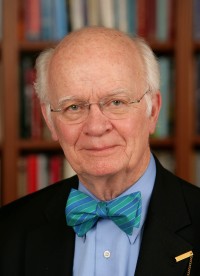Rough treatment
Barton Swaim, reviewing Elesha J. Coffman’s The Christian Century and the Rise of the Protestant Mainline for the Wall Street Journal (subscription required), wrote this:
Nor were the editors [of the Christian Century] above dirty tricks, at one point even hiring an investigative reporter to find some impropriety in [the Billy Graham] organization’s finances. None came to light, but in something of a scoop, Ms. Coffman has discovered documents linking the revered historian Martin Marty to the rough anti-Graham campaign.
As far as Coffman’s book goes, I have only the usual quibbles that a historian voices when reviewing the work of another historian. It is Swaim who is unfair to the magazine. Since I am the only surviving editor mentioned in his piece about 56-year-ago events, I will comment.
Swaim is not wrong about the Century’s critique of Billy Graham at the time of his New York Crusade in 1957. It was rough, as exemplified by the writings of then-editor Harold E. Fey and by the magazine’s founder, Charles Clayton Morrison, who, though blind at age 83, bestirred himself out of long retirement to fire away. The two regarded Graham’s cause as being simply fundamentalism redivivus.
Coffman quotes someone paraphrasing me at a Century editorial conference in April 1957: Graham’s forthcoming crusade was “going to launch a national pattern for fundamentalist revivalism which may take several years to run its course.” While I’ve spent decades writing on how “fundamentalist revivalism” evolved into modern evangelicalism, the reference to a course being run in “several years” revealed a lack of vision, as we can see 56 years later.
Writing of a “scoop” about “dirty tricks” evokes the likes of Charles Colson, Richard Nixon and Watergate—and reporters like Bob Woodward. The reporter the Century hired to look into Graham was evidently only a denominational correspondent.
Swaim has me typifying the Protestant “mainline” during that rough campaign against Graham, but I was not even in the not-yet-named mainline. I was at the time a Missouri Synod Lutheran missionary pastor, helping scrape together a suburban congregation and the funds to build a church. I was free to drop in to the magazine office weekly for coffee and editorial chit-chat, but don’t remember anything as dignified or formal as an editorial conference. A few weeks before the crusade, I was a Ph.D. student—and what do they know?
I did have some book knowledge of fundamentalism, which Graham in those years represented. You could look it up. My disagreements with Graham were ecclesiastical (e.g., over the term “evangelical”) and theological (over the meanings and forms of baptism). These were not the kind of issues which would have held most Century readers’ attention.
I was then writing my first Century articles, which became my first book, which focused less on Protestant decline in the face of fundamentalist aggression than on the nameless, formless phenomenon which I called “Religion-in-General.” The book was often reviewed alongside others by Gibson Winter and Peter Berger. We and our scholarly, journalistic and pastoral colleagues in what later came to be called the mainline were more occupied critiquing our own forms of Christian expression than we were attacking fundamentalism.
My first “Editorial Correspondence” for the Century (June 12, 1957), titled “A Tale of Two Cities,” reported on my time at Madison Square Garden in May during the New York Crusade. Having reread it, I still strongly agree with its thesis. I wrote that Graham addressed first secular New York City, with an intent to convert the pagans in Babylon, and second the already churched residents of New York and the thousands of other already faithful visitors who turned out for the crusade and whom Graham confirmed in their faith and church life.
All that was long ago. After 1957 Billy Graham changed, fundamentalism/evangelicalism changed, American culture changed, and—I confess and hope—I also changed. My books eventually came to have many references to the “mainline,” a term I regretted but had to use. Through the years I was invited as a friendly guest to conferences on Graham-style evangelical themes. When I would be introduced as “this year’s invited nonevangelical,” I reminded the company that I was usually the only person in the room who belonged to a church body with the word “evangelical” in its name.
Through the years a couple of private letters from and to Billy Graham fostered a conversation at a distance. Whoever knows him, his record and his style can picture him as he was in those contacts: generous, friendly and theologically concerned.
Swain thinks he can improve on Coffman’s book by making her account rougher. But his view of the social positions of the magazine is arbitrary and idiosyncratic, and his critique of “liberal Protestant” theologians implies that they are unbelievers, guilty of bad faith.
His complaints about the “smugness,” “unkindness” and “contemptuousness” displayed by some Century writers and other mainliners may be valid, but students of bruising rhetoric can also find violent language among the fundamentalists of the period—as has been documented by numerous fine books written by evangelicals. That one finds little of this roughness in the middle and late career of Billy Graham is a reminder that he was always ready to learn but also to teach, including to teach even some of us slow learners from those olden days.



